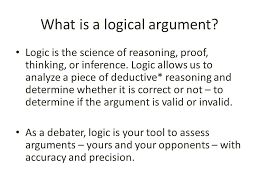Development of strong theorem statements
Summary:
The statement of the case or the main claim must be debatable
The argumentative or concluding part of the text must begin with a controversial proposition or claim. In other words, it has to be something that people can logically have different opinions about. If your theorem is something that is normally accepted or accepted as a fact, then there is no reason to try to convince people.
Example of a non-controversial theorem statement:
Pollution is bad for the environment.
This statement is not debatable. First, the word pollution means something bad or in a negative way. Previously, all studies agreed that pollution is a problem; They simply disagreed on what effect it would have or the area of the problem. No one can logically argue that pollution is good.
Example of a controversial theorem statement:
At least 25 percent of the federal budget should be spent on reducing pollution.
This is an acceptable example because rational people can oppose it. Some people may think that this is the case where we have to spend the national currency. Others may feel that we have to spend more money on education. They will still be able to argue with those companies, not the government, that they have to pay to limit pollution.
Another example of a controversial theorem statement:
US anti-pollution efforts should focus on private cars.
In this example, there is also room for disagreement between rational people. Some citizens may think that focusing on recycling programs is the most effective strategy compared to private cars.
The theorem needs to be precise (deep)
Although the scope of your article may seem confusing at first, in general the more accurate the case, the more effective your argument will be. Your thesis or claim must be supported by evidence. The broader your claim, the more understanding you will need to persuade readers to show that you are right.
An example of a very broad theorem:
Substance use is harmful to society.
There are several reasons why this statement is too broad to argue. First, what is included in the category of materials? Does the author talk about illegal substance use, recreational substance use (which may include alcohol and smoking), or all drug use in general? Secondly, in what ways are entertainment materials? Does substance use lead to death (and does the author equate deaths from overdoses and deaths from substance-related violence)? Does substance use change the moral climate or lead to the collapse of the economy? Finally, what does the author mean by society? Does the author refer only to the United States or the world population? Does the author make any distinction between the effects on children and adults? There are many questions that leave the claim open. The author cannot cover all of the topics listed above, so the general part of the statement leaves all of these possibilities open for discussion.
Example of a precise or focused theorem:
The use of illicit substances is dangerous because they exacerbate gang violence.
In this example, the subject matter of the material is clearly defined as illegal material, and the damage is limited to group violence. This is an issue with more management quality.
We can limit any debatable theorem from the previous examples in the following ways:
Limit the controversial theorem 1:
At least 25 percent of the federal budget should be used to help improve the clean-up technology business, research renewable energy sources, and plant more trees to control or eliminate pollution.
This has clarified the scope of the argument, which limits not only the amount of money used but also how money can actually help control pollution.
Limiting Controversial Theorem 2:
US anti-pollution efforts should focus on private cars because they will allow more citizens to strive for national efforts and care about the outcome.
This limits the scope of the argument by specifying not only what the focus of the national anti-pollution campaign should be but also why it is appropriate.
Descriptive words such as, for example, generally, usually or on average, help to limit the scope of their claim by allowing for an almost inevitable exception to the law.
Types of claims
Claims are typically divided into four categories. Thinking about how you want to approach your subject, in other words, what kind of claim you want to make, is a way to focus your case on a specific aspect of your broader subject.
Claim of Truth or Definition: These claims discuss what is the definition of something or what determines the truth. Example:
What some people refer to as global warming is nothing more than the usual long cycles of climate change.
Claims of Cause or Impact: These claims argue that a person, thing, or phenomenon causes something or another phenomenon to occur. Example:
The popularity of SUVs in the United States has led to increased pollution.
Value claims: These are claims that are made about what is valuable, whether we value it or not, how we rate or categorize something. Example:
Global warming is the most impactful challenge facing the world today.
Claims about solutions and policies: These are claims that argue for or against a solution or policy close to an issue. Example:
Instead of drilling for oil in Alaska, we should focus on ways to reduce oil consumption, such as researching renewable energy sources.
What kind of claim is true to your argument? What kind of proposition or claim you use for your argument will depend on the position or knowledge of your subject, your audience, and the content of your article. You may want to think about portraying your audience on this issue and carefully determine where you think the biggest difference in point of view may be. Even if you start with a sample claim, you will probably use several types in the article. Regardless of the type of claim you choose to use, this is the key to identifying the difference or argument you are considering and defining for your recent position in the article.
Logic in argumentative writing
Summary:
This resource covers the use of logic in writing - logical words, logical errors, and other types of logic-based reasoning.
Contributors: Ryan Weber, Ellen Breeze
Last Edit: 09-02-2018 12:53:15
This booklet is designed to help authors develop and use logical reasoning in writing. This booklet helps authors analyze the arguments of others and generate their own arguments. However, it is important to remember that logic is only one aspect of a successful argument. Irrational arguments, statements that can not be logically proved or disproved, are important in argumentative writing - such as appealing to feelings and values. Unreasonable arguments, on the other hand, are wrong and should be avoided.
Logic is a formal system of analysis that helps authors invent, demonstrate, and substantiate arguments. Works by testing propositions against each other to determine their correctness. People often think that they use logic when they avoid emotions or make arguments based on their common sense, such as "everyone should take care of their own interests" or "people have the right to be free". . However, non-emotional or common-sense statements are not always equivalent to logical statements. To be logical, a proposition must be tested in a logical sequence.
The most famous logical sequence is called logical analogy, which was developed by the Greek philosopher Aristotle. His most famous logical analogy is as follows:
Hypothesis 1: All human beings are mortal.
Hypothesis 2: Socrates is human.
Conclusion: Therefore, Socrates is mortal.
In this sequence, Hypothesis 2 is tested against Hypothesis 1 to reach a logical conclusion. In this system, if both hypotheses are considered valid, there is no other logical conclusion than to determine that Socrates is mortal.
This guide provides some vocabulary and strategies for determining logical conclusions.
Organize your argument presentation
This presentation is designed to introduce your students to the elements of an organized article, including an introduction, theorem, main paragraphs, subject sentences, counter-arguments, and conclusions.
Report (Posted)
Logic is a formal system of analysis that helps authors invent, demonstrate, and substantiate arguments. Works by testing propositions against each other to determine their correctness. People often think that they use logic when they avoid emotions or make arguments based on their common sense, such as "everyone should take care of their own interests" or "people have the right to be free". . However, non-emotional or common-sense statements are not always equivalent to logical statements. To be logical, a proposition must be tested in a logical sequence.
The most famous logical sequence is called logical analogy, which was developed by the Greek philosopher Aristotle. His most famous logical analogy is as follows:
Hypothesis 1: All human beings are mortal.
Hypothesis 2: Socrates is human.
Conclusion: Therefore, Socrates is mortal.
In this sequence, Hypothesis 2 is tested against Hypothesis 1 to reach a logical conclusion. In this system, if both hypotheses are considered valid, there is no other logical conclusion than to determine that Socrates is mortal.
This guide provides some vocabulary and strategies for determining logical conclusions.
Organize your argument presentation
This presentation is designed to introduce your students to the elements of an organized article, including an introduction, theorem, main paragraphs, subject sentences, counter-arguments, and conclusions.
Report (Posted)
Introduction, main paragraphs and conclusion for an argumentative article
Summary:
The instructions in this resource are a generally accepted structure for introductions, main paragraphs, and conclusions in an academic argumentative paper. Keep in mind that this resource contains instructions, not precise rules for organizing. Your structure needs to be flexible enough to meet the needs of your target audience.
The following sections outline the overall acceptable structure for an academic argumentative paper. Keep in mind that these are guidelines and that your structure needs to be flexible enough to meet the needs of your target audience.
Tips and examples for writing propositions
Summary: This resource provides tips for creating proposition statements and examples of different types of proposition statements.
Tips for writing your case statement
Determine what kind of article you are writing:
An analytical article breaks down a topic or idea into its component parts, evaluates the topic or idea, and provides that segmentation and evaluation for the audience.
An interpretive article explains something to the audience.
An argumentative article makes a claim for a subject and justifies that claim with a certain piece of evidence. A claim can be an opinion, a political proposal, an assessment, a statement of cause and effect, or an interpretation. The purpose of the argumentative article is to convince the audience that the claim is true based on the evidence presented.
If you are writing a text that is not affected by these three categories (for example, a story), a statement statement somewhere in the first paragraph can still be useful to your reader.
Your case statement should be clear - this should cover only what you will be discussing in your article and should be supported by a specific document.
The statement usually appears at the end of the first paragraph of the article.
Your topic may change as you write, so you may need to modify your thesis statement to carefully review what you should discuss in the article.
Examples of theorem statements
Example of a statement of an analytic theorem
Analysis of a college admissions process reveals the challenge of facing counselors: admitting students with high test scores or students with strong extracurricular activities.
The following article should:
Explain the analysis of the college admission process.
Explain the challenge of facing admissions counselors.
Example of a statement of an explanatory theorem:
The life of a typical college student is determined by the amount of time he or she spends studying, attending class, and socializing with peers.
The following article should:
Explain how students spend their time studying, attending classes, and socializing with peers.
Example of a statement of reasoning:
High school graduates should be required to take one year off to pursue community service projects before entering college to enhance their maturity and global awareness.
The following article should:
Provide an argument and provide evidence to support the claim that students should pursue social projects before entering college.
How can I effectively present my argument?
Use an organized structure that sets the argument in a way that is understandable to the reader. The Tolmin method of logic is a common and easy-to-use formula for organizing an argument.
This is the basic format for the Tolmin method.
Claim: A general proposition that the author will discuss.
Data: Evidence gathered to support the claim.
Justification (also referred to as a bridge): Explain why or how the data supports the claims, the main premise that connects your data to your claims.
Support (also referred to as the basis): Additional logic or reason that may be necessary to justify support.
Counterclaim: A claim that denies or contradicts the theorem / claim.
Rejection of a claim or cross-argument: Evidence that
Deny or oppose the counterclaim.
Considering a well-thought-out justification or bridge is essential to writing a good argumentative essay or article. If you present data to the audience without explaining how it supports your theorem, your reader may not make the connection between the two, or they may draw different conclusions.
Do not shy away from the opposite side of an argument. Instead, think of these as actions that you must take on a regular basis. Discover what the other side has to say and respond with your own argument. It is important that the audience is not influenced by weak but dissatisfied reasoning. It also makes you look more trustworthy because you are aware of participating in the discussion rather than just being neutral or ignorant. You may want to consider several cross-claims to show that you are fully aware of the issue.
Example:
Claim: Hybrid cars are an effective strategy to fight pollution.
Data 1: Driving a personal car is a normal activity of polluting a citizen's air.
Justification 1: Because cars are the biggest personal resource, in contrast to the manufacturing industry, air pollution, switching to hybrid cars should have an effect on air pollution.
Data 2: Every car produced on the road will last for approximately 12 to 15 years.
Rationale 2: Cars generally have a long service life, meaning that a decision to switch to a hybrid car will have a long-term effect on pollution levels.
Data 3: Hybrid cars combine a gasoline engine with an electric motor with a battery power supply.
Rationale 3: This combination of technologies means that less pollution is generated. According to indeedknow.org, Toyota's Prius hybrid engine produces 90 percent less emissions than a comparable gasoline engine.
Reciprocal claim: Instead of focusing on cars, which continue to reinforce driving culture, even if it reduces pollution, the country should focus on building and encouraging the use of mass transfer systems.
Rejection of Mutual Claim or Argument: As long as mass transfer seems to be an environmental idea that needs to be strengthened, it is not possible in many rural and suburban areas, or for people who have to relocate for work; Hence, hybrid cars are a better solution for the majority of the country's population.
Organize your argument presentation
This presentation introduces your students to the elements of an organized article, including an introduction, theorem, main paragraphs, subject sentences, cross-arguments, and conclusions.
Logic in argumentative writing
Summary: This resource covers the use of logic in writing - logical words, logical errors and other types of reasoning based on logic.
This article is designed to help authors develop and use logical reasoning in writing. This booklet helps authors analyze the arguments of others and generate their own arguments. However, it is important to remember that logic is only one aspect of a successful argument. Irrational arguments, statements that can not be logically proven or disproved, are important in argumentative writing - such as appealing to emotions or values. Unreasonable arguments, on the other hand, are wrong and should be avoided.
Logic is a formal system of analysis that helps authors invent, articulate, and substantiate arguments. It works by testing propositions against each other to determine their correctness. People often think that they use logic when they refrain from emotions or make arguments based on their usual sense, such as that everyone should find their own interests or that people have the right to be free. However, non-emotional or common sense statements are not always equivalent to logical statements. If we want to be logical, a proposition must be tested in a logical sequence.
The most famous logical sequence is called logical analogy, which was developed by the Greek philosopher Aristotle. His most famous logical analogy is as follows:
Hypothesis 1: All human beings are mortal.
Hypothesis 2: Socrates is human.
Conclusion: Therefore, Socrates is mortal.
In this sequence, Hypothesis 2 is tested against Hypothesis 1 to reach a logical conclusion. In this system, if both hypotheses are considered valid, there is no other logical conclusion than to determine that Socrates is mortal.
This guide provides some vocabulary and strategies for determining logical conclusions.
 English
English Persian
Persian

